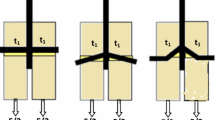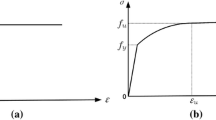Abstract
A theoretical model is presented to calculate the stress distribution around a pin-loaded hole in a timber joint and to predict brittle failure modes in bolted connections. The analytical solution uses the stress functions expressed in terms of complex parameters, and it can be considered an application of Lekhnitskii’s theory on stress distributions in anisotropic plates. The influence of the end distance and material properties on development of failure due to the splitting and shear-plug is shown for a dowel-type timber joint. Laboratory experiments on timber joints with 15.9-mm and 9.5-mm bolts loaded parallel to grain have shown good agreement with the model predictions.







Similar content being viewed by others
Abbreviations
- A :
-
Complex constant
- B :
-
Complex constant
- b :
-
Width of plate
- d :
-
Diameter of the bolt
- D :
-
Diameter of the hole
- e :
-
End distance
- E x :
-
Perpendicular-to-grain modulus of elasticity
- E y :
-
Longitudinal modulus of elasticity
- F :
-
Resultant force
- G xy :
-
Shear modulus
- p :
-
Average bearing stress
- R :
-
Radius of the hole
- S ij :
-
Elastic compliances of the plate material
- λ :
-
Clearance
- u 1, u 2 :
-
Constants
- z k :
-
Complex variable
- μ 1, μ 2 :
-
Complex parameters of the first order
- ν yx :
-
Coefficient of Poisson
- σ x :
-
Perpendicular-to-grain stress
- σ y :
-
Longitudinal stress
- τ xy :
-
Shear stress
- \(\varphi (z_{1})\) and \(\Uppsi (z_{2})\) :
-
Complex stress functions
References
American society for testing and materials (ASTM) (2006) D143-94 Standard methods of testing on small clear specimens of timber. ASTM Annual Book of Standards, West Conshohocken, PA
American society for testing and materials (ASTM) (2006) D2395-02 Standard test methods for specific gravity of wood and wood-based materials. ASTM Annual Book of Standards, West Conshohocken, PA
American society for testing and materials (ASTM) (2006) D5764-97a Standard test method for evaluating dowel-bearing strength of wood and wood-base products. ASTM Annual Book of Standards, West Conshohocken, PA
Collings TA, Beauchamp MJ (1984) Bearing deflection behaviour of a loaded hole in CFRP. Composites 15:33–38
Dano ML, Gendron G, Picard A (2000) Stress and failure analysis of mechanically fastened joints in composite laminates. Compos Struct 50:287–296
De Jong T (1977) Stresses around pin-loaded holes in elastically orthotropic or isotropic plates. J Compos Mater 11:313–331
Echavarría C (2004) Analyse d’une plaque orthotrope avec trou: application aux assemblages en bois. Ph.D. Thesis No. 2947, Swiss Federal Institute of Technology Lausanne EPFL, Switzerland
Echavarría C, Haller P, Salenikovich A (2007) Analytical study of a pin-loaded hole in elastic orthotropic plates. Compos Struct 79:107–112
EN 26891 (1991) Timber structures - Joints made with mechanical fasteners - General principles for the determination of strength and deformation characteristics. (ISO 6891; 1983)
Jorissen A (1998) Double shear timber connections with dowel type fasteners. Delft University Press, Delft
Kharouf N, McClure G, Smith I (2005) Postelastic behavior of single- and double-bolt timber connections. ASCE J Struct Eng 131(1):188–196
Lekhnitskii SG (1968) Anisotropic plates. Gordon and Breach Science Publishers, New York
Muskhelishvili NI (1953) Some basic problems of the mathematical theory of elasticity. Noordhoff, Groningen
Okutan B (2002) The effects of geometric parameters on the failure strength for pin-loaded multi-directional fiber-glass reinforced epoxy laminate. Compos Part B 33:567–578
Patton-Mallory M, Cramer S, Smith F, Pellicane P (1997) Nonlinear material models for analysis of bolted wood connections. ASCE J Struct Eng 123(8):1063–1070
Quinn WJ, Matthews FL (1977) The effect of stacking sequence on the pin-bearing strength in glass fibre reinforced plastic. J Compos Mater 11:139–145
Wood Handbook: Wood as an engineering material (1999) Forest products laboratory. US Department of Agriculture, Madison, WI
Wong CM, Matthews FL (1981) A finite element analysis of single and two-hole bolted joints in fibre reinforced plastic. J Compos Mater 15:481–491
Zhang K, Ueng C (1985) Stresses around a pin-loaded hole in orthotropic plates with arbitrary loading direction. Compos Struct 3:119–143
Author information
Authors and Affiliations
Corresponding author
Rights and permissions
About this article
Cite this article
Echavarría, C., Salenikovich, A. Analytical model for predicting brittle failures of bolted timber joints. Mater Struct 42, 867–875 (2009). https://doi.org/10.1617/s11527-008-9428-0
Received:
Accepted:
Published:
Issue Date:
DOI: https://doi.org/10.1617/s11527-008-9428-0




